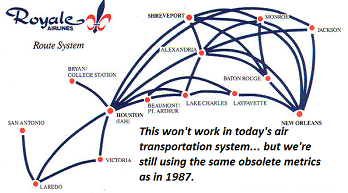Moving Information & Business Intelligence
Out of The Past
You’ve probably noticed, aviation has changed. Airline structures and route systems have changed. Consumer patterns have changed.
Remember all that intra-regional air service in the 1980s? It’s gone. Air transportation evolved, and it is still evolving. The economic underpinnings and business base of aviation aren’t the same as just a decade ago. It’s not the same business, and it’s economic role has shifted and continues to do so.
But aviation intelligence and data sources are still stuck in the past. They measure yesterday.
Do Those Historical Metric Channels Apply To An Industry Now With A220s, 787s, and A321s? The answer is no. The aviation industry is evolving, and so, too is its role within communication channels and modalities.
 The future is in identifying and quantifying the trends that will shape the future. It’s great to have access and analysis of historical data, but when the very foundation drivers of those data are changing, relying on past data is a certain way to stay there. In the past.
The future is in identifying and quantifying the trends that will shape the future. It’s great to have access and analysis of historical data, but when the very foundation drivers of those data are changing, relying on past data is a certain way to stay there. In the past.
Sure, it’s great to have access to historical O&D and T-100 data and other metrics. But increasingly, these are reflective of an air transportation industry that in three years will be fundamentally different. Measuring yesterday is not viable for planning for tomorrow.
New approaches to developing futurist planning metrics are needed. New data and research approaches – beyond just BTS information – are imperative. At Boyd Group International, we’re working on it.
New Fleets. New Missions. A New Communication Channel. It’s a future where whole new fleets are changing the structure of airline route systems.
One example is internationalization – it’s coming to airports in the U.S. where even such a suggestion ten years ago would have called into question the chain of custody of a person’s last drug test. Okay, what are the baseline metrics in regard to forecasting which interior U.S. airports will see trans-Atlantic flights? What are the performance measures – remember, current DOT O&D reporting of international traffic is a disaster. Developing new approaches to measuring these data isn’t a priority at the BTS.
Then there’s the ULCC model, which has shifted not only travel usage, but even the role of travel as part of consumer discretionary spend. It’s not filling air service voids – instead it’s creating a new profitable use of airliners. Where are the fertile opportunities? What “submarine” markets may emerge? Tossing out an O&D report from 2019 won’t do diddly in that regard.
Local Air Service At Some Small Communities Is Increasingly Obsolete Air Service. Consumer preferences at smaller cities – civic hubris notwithstanding – has combined with raw economics to make regionalization of air access a superior option to trying to “lure” flights back to the local airport – flights that nobody will use, and often on airlines right from the start of the “true market study” simply don’t exist.
Yet these programs are continually being foisted on unwary small airports, when it’s obvious to any ethical professional that in the new airline realities (fleets, costs, strategies and consumer trends) there is zero chance of gaining flights that are consumer-competitive with other existing channels consumers are already using. This stuff will peter out in the future, the victim of reality.
In addition, there’s been a lot of well-intentioned efforts, too. Remember the big study done by the Transportation Research Board a couple of years ago, aimed at finding solutions to “small airport air service?” Lots of fine folks participated, and the final report was issued almost two and a half years ago. Many suggestions provided.
The results? Zero. Nada. That’s because they were focused at bringing flights to small airports, instead of the real objective – assuring air access for consumers. Actually, the consumer and the concept of comparative consumer preferences and – importantly – the emerging of qualitative superiority of air service at alternative airports, were ignored completely.
New Aviation Logistical Channels Need New Metrics. As we covered at the 24th Boyd Group International Aviation Forecast Summit in Las Vegas last August, drone – UAS – technology is shaping up to transform the logistical base of America, bringing new economic growth to rural airports, lack of scheduled passenger service notwithstanding.
Rethinking Metrics & Data. So, over the next several weeks, Boyd Group International will be undergoing a complete review and update of our information systems, including AvaitionPlanning, Airports:USA, Aviation DataMiner, and even our newest addition now under development, BoydGroupChina.com.
We will be tackling this issue and revising our own research and forecasting outreach.
But one thing is certain: a lot of the air service planning in the works today does not have access to the analytical support it really will need.
___________
FROM ALL OF US AT BOYD GROUP INTERNATIONAL, HAVE A GREAT WEEK!